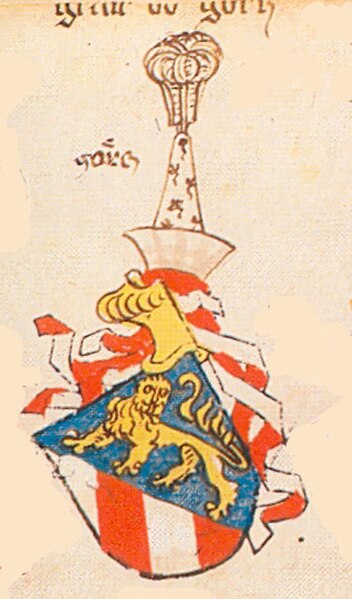Henry of Gorizia, a member of the House of Gorizia, was Duke of Carinthia and Landgrave of Carniola and Count of Tyrol from 1295 until his death, as well as King of Bohemia, Margrave of Moravia and titular King of Poland in 1306 and again from 1307 until 1310. After his death, the Habsburgs took over Carinthia and Carniola and held them almost without interruption until 1918.
16th-century portrait of Henry of Bohemia in the Spanish Hall of Ambras Castle, near Innsbruck
Seal of Duke Henry of Carinthia, 1303
Tomb slab in Stams Abbey
The Counts of Gorizia, also known as the Meinhardiner, House of Meinhardin, were a comital, princely and ducal dynasty in the Holy Roman Empire. Named after Gorizia Castle in Gorizia, they were originally "advocates" (Vogts) in the Patriarchate of Aquileia who ruled the County of Gorizia (Görz) from the early 12th century until the year 1500. Staunch supporters of the Emperors against the papacy, they reached the height of their power in the aftermath of the battle of Marchfeld between the 1280s and 1310s, when they controlled most of contemporary Slovenia, western and south-western Austria and north-eastern Italy mostly as (princely) Counts of Gorizia and Tyrol, Landgraves of Savinja and Dukes of Carinthia and Carniola. After 1335, they began a steady decline until their territories shrunk back to the original County of Gorizia by the mid 1370s. Their remaining lands were inherited by the Habsburg ruler Maximilian I.

Coat of arms of the Counts of Görz, Ingeram Codex of Archduke Albert VI of Austria, 1459
Historical sketch of the inheritance of the Princely County of Gorizia in favor of Austria in 1500. Protagonists from left to right around the castle of Gorizia and the Venetian opponent (flag and gold ducats): Administrator Virgil von Graben, Count Leonhard von Gorizia, King (Emperor) Maximilian I. as well as Lukas von Graben (zum Stein), son of Virgil and deputy administrator of Gorizia (sketch by Matthias Laurenz Gräff)
The origin (emergence) of the Herren von Graben from the houses of Görz (Meinhardiner) [left] and possibly Orsini [right] in a historical sketch by Matthias Laurenz Gräff (2024).
Görz coat of arms, as drawn by Hugo Gerard Ströhl, 1890






![The origin (emergence) of the Herren von Graben from the houses of Görz (Meinhardiner) [left] and possibly Orsini [right] in a historical sketch by Ma](https://upload.wikimedia.org/wikipedia/commons/thumb/e/e1/Der_Ursprung_%28die_Entstehung%29_der_Herren_von_Graben.jpg/550px-Der_Ursprung_%28die_Entstehung%29_der_Herren_von_Graben.jpg)
